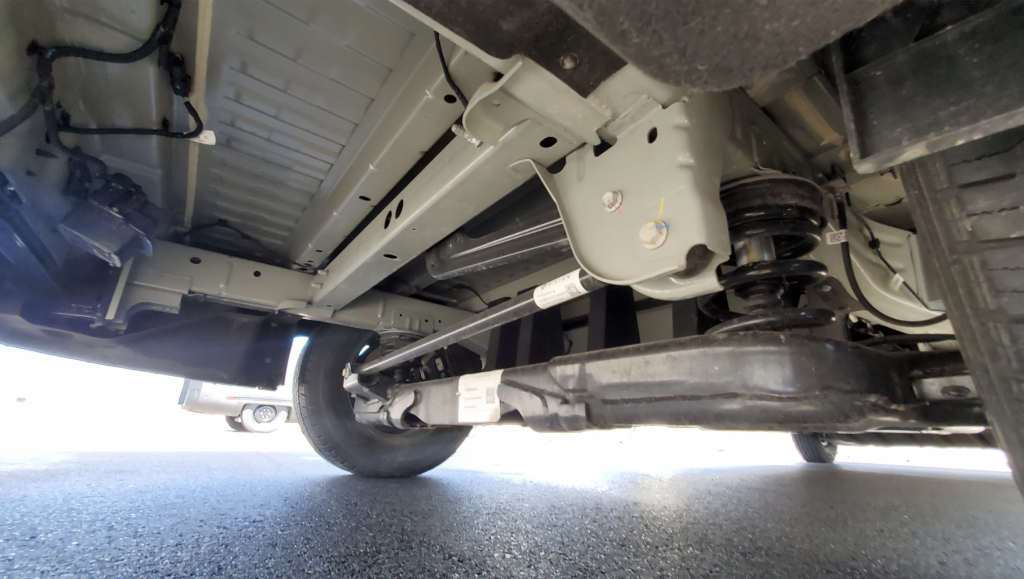Really, I stopped because I knew my coworker Jason would have a lot to say about the vehicle’s lighting situation. The rear taillight, in particular, is truly special, as Jason makes clear in his analysis below. As for what I have to say about this machine? Well, naturally I slid underneath to look at the hardware.
Now that we know what we’re looking at, let’s check out what’s going on underneath. Just under the rear bumper, looking forward, you’ll see a steel skateboard/frame with a steel body mounted up top. The rear suspension is a coil-sprung torsion beam design located laterally by a track bar (a cheap but robust design, you’ll find something like this under the back end of an entry-level front-wheel drive car like a Hyundai Accent). I did notice that the track bar mount on the frame looks to have another stamped steel piece bolted to it — I’m wondering if this acts as a reinforcement for the bracket welded to the frame? (I.e. to make sure the track bar bracket welds don’t fail under high loads?).
Quick note: I don’t know what that rectangular prism on the left side of the photo above is. It looks almost like a stack-style heat exchanger, but obviously it’s something electrical based on the wires going to it. Hmm. Update: I’m told it’s a noisemaker so people can hear the vehicle when it’s moving. Looking back at the rear suspension from ahead of the rear axle you can see one of the enormous trailing arms mounted to the frame, and you can see a seriously gigantic aero shield that diverts air under the rear suspension:
Also visible in the image above is a small tire spat (as Chrysler’s aero team called them) just ahead of the rear wheel to reduce drag. There are some spats up front, too, as well as a big plastic aero shield:
That front aero shield is long. It starts just under the front fascia and continues under the front subframe, under the drive unit, and then just keeps on going:
And going:
Eventually it comes to an end, exposing the battery pack shield. You’ll see how there’s only a small bit of the underbelly exposed, as that huge rear aero shield meant to divert air under the twist beam reaches quite far forward:
Let’s move back towards the front of the car and peek at the suspension: It’s a double-wishbone design. And, as a reader pointed out in the comments below, you’ll notice that there’s no coilover or coil spring or traditional leaf spring or torsion bar. Instead, you’ll see a white thing attached to the top of the lower control arm — that’s a composite transverse leaf spring. That’s pretty bizarre if you’re used to passenger cars (as for cargo vans, I’m told the Iveco Daily cargo van uses a similar spring arrangement). You might recall seeing such a layout in a Chevy Corvette or an SPA-platform Volvo, with the former more similar to this EDV since it also uses a transverse leaf as part of the front suspension. Another vehicle with a transverse front leaf spring? The Ford Model T!.
You’re naturally going to be curious if any of the parts are common with those of the R1T, and — looking at the two together (that’s the R1T’s front suspension below) — I’d say maybe the tie rod ends, but that’s about it. The basic front suspension design is similar, sure, but as for parts sharing, I don’t see anything obvious:
Now let’s look at the really good stuff — the drive unit.
This is a front-wheel drive truck, so the drive unit sits just aft of the front axle, with the gearbox output ahead of the motor. Notice how the unit hangs off the frame via what looks like a cast aluminum bracket that bolts onto a mount on the frame. I find this interesting, because presumably this drive unit is fastened to the front subframe, which is fastened to the main vehicle chassis/frame. So why fasten the motor directly to the frame? I’m assuming the drive unit-to-subframe mounting scheme doesn’t constrain the motor sufficiently, so under load, the motor would want to torque — this frame mount is there to prevent that. And I’m guessing it was just easier, perhaps from a packaging standpoint, than constraining the motor via the subframe? Maybe it’s not that weird. Maybe a drive unit-direct-to-body mounting isn’t that uncommon among EVs? Munro would know.
Anyway, you can see that all the power electronics sit aft of the front drive unit, just ahead of the battery pack, and hidden by that huge front aero shield.
Lighting Design: This Section Written By Jason Torchinsky
They’re appealing round units, with an inner clear projector lens and an outer pair of half rings that functions both as a DRL and turns amber for indicator use.
They’re not exactly revolutionary, but the decision for simple round light graphics and that flat glossy black panel is a welcome change from the normal default of an overdone grille and squinty-blob light units that give vehicles a perpetually pissed look. The EDV 700 looks friendly and eager, like a whale who’s here to help. Around back, though, we get into something really special. I’ll let David’s earnest shock set the mood here: I think David is exactly right; this is very likely the longest taillight ever developed by human hands. Even recent Escalades and Volvo V70s, with their massive full D-pillar taillight towers can’t match what’s going on here. The back of the Rivian van looks a bit like it’s designed to dock with a special port, like a spacecraft, with a protruding lip that you can imagine acting as a sort of hermetic seal.
Around that seal, starting about 1/4 from the bottom of the van and going up, over, and down like a horseshoe, is the taillight strip, a ring road of red light. It all appears to be able to illuminate, and at top the strip blisters to form three red clearance lamps. The bottom ends form L shapes on both sides and there’s a dark glossy area that house the rear turn indicators, which, based on video I’ve seen, appear to be red instead of amber, which is disappointing.
Brake lamps may be here as well, or the big red inverted “U” may light up, or both; I haven’t see that yet.
Reverse lamps and reflectors are housed in a pair of frankfurter-shaped units below the rear door. Seems like there would have been plenty of room for these in the main lights, but maybe the reverse lamps give better lighting below? They could also serve to illuminate that step, perhaps?
The Interior
Urine aside, the interior looks pretty good; lots of hard-wearing-looking vinyls and rubbers and plastics. The blue accents (and kicky blue seatbelt) give some nice color interest to the otherwise grayscale interior, and that seat looks well-padded and comfortable. The legroom is a little unusual, with a sort of step that runs the length of the cab under the dash, but it doesn’t appear anyone would actually be cramped. The passenger’s side appears to have a folded jump seat, though it’s likely only for very occasional use, like if Jeff Bezos wanted to ride shotgun or something. The instrument cluster appears to be an all LCD screen setup, and the center-stack screen is a landscape-oriented widescreen LCD panel. Not that that’s a bad thing. David! For those of us who aren’t as familiar with car parts as you, open up Preview on your Mac and add some red arrows so we know what you are talking about! It will interesting to see this in service and get some data on range and costs I assume they’ll need to charge many vehicles overnight, all at once or in shifts with someone to change over the plugs halfway through the night. Either way that’s a lot of level 2 chargers. I often learn something new from a DT writeup, so please keep up the good work.
























